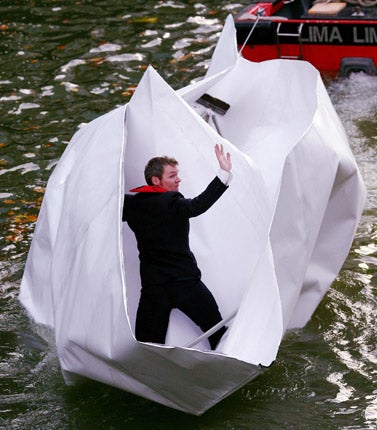The great paper caper
Origami has long been appreciated as an art form, but now folding fans are creating boats and even spacecraft, says Genevieve Roberts

Paper, a silent essential that can bear messages ranging from the mundane to the exciting, has stepped into the limelight: this week the 2,000 year-old material flew in from outer space.
A paper aeroplane was launched into space by amateur enthusiasts Steve Daniels, John Oates and Lester Haines. A helium balloon carried the glider – made of paper straws and fitted with a camera – 17 miles into space before exploding, as planned. The airplane glided back to Earth, taking stunning pictures on its 90-minute descent.
Meanwhile artist Frank Bölter drifted down the Thames in an origami boat made entirely of paper. He had asked members of the public to help him fold his giant sheet of paper into a hat-like boat, named To The World's End, before floating off towards central London, as part of the Drift10 biennial art exhibition.
David Woodroffe, author of The Complete Paper Aviator, has been making planes since childhood. He says: "Paper is a strong substance, especially if it is designed in the right way – as the Japanese have always known. It's versatile, and also cheap. I hope we're going to see a resurgence in paper as an art form, now that it's being used less for mundane bills."
Paul Sloman, who has edited a book on paper as artwork, Paper: Tear Fold Rip Crease Cut, believes we are on the cusp of a creative paper renaissance: "I have always thought that such a precious medium is wasted on bank statements and train tickets." Paper, he explains, "began as a highly precious material, and has only really existed as a mass-produced carrier of disposable information during our rather wasteful 20th century. There's now a renewed appreciation of the qualities of paper."
No longer the medium of choice for council-tax bills, paper is increasingly seen as a material of many more imaginative uses – whether for recycled home insulation, furniture, transport or art installations. It's a material that fashion designers often return to.
In February, designer Gary Harvey opened New York Green Fashion Week with a couture dress made from 30 copies of The Financial Times. Designer Michael Cepress uses copies of the Yellow Pages to fashion men's collars.
And Bjork (who is no stranger to pushing the fashion envelope) posed in a paper jacket designed by Hussein Chalayan for the cover of her 1995 album, Post.
While designers now use paper to promote recyclability, paper dresses originated as disposable wear in 1966, with a promotion from the Scott Paper Company of America, which made of toilet paper and paper tissues. Scott offered a "Paper Caper" dress for a coupon and $1.25 – but soon ran out of the 500,000 dresses on offer.
Other brands followed its example, and these paper frocks are now collectors' items: two years ago, Christie's sold a "Souper dress", a Campbell's Soup design inspired by Andy Warhol's work for $3,000.
Origami, the Japanese art, isn't limited to swans. Los Angeles-based illustrator Jeff Nishinaka has been carving and pinching paper to make paper sculptures of up to 20ft for the last 28 years. His work is displayed in department stores including Bloomingdale's and Galeries Lafayette in Paris.
Nick Robinson, author of The Encyclopedia of Origami, believes that while some uses for paper are becoming obsolete, the material will flutter on into the future as an artistic medium. "A world without paper is unimaginable," he says.
Join our commenting forum
Join thought-provoking conversations, follow other Independent readers and see their replies
Comments
Bookmark popover
Removed from bookmarks